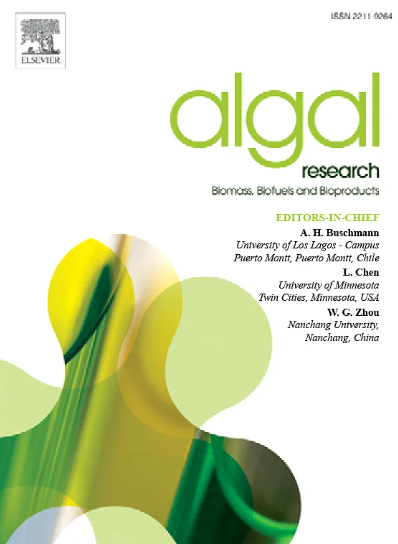描述了一种新的极端微生物绿藻,太平洋衣藻及其作为生物技术宿主的潜力
IF 4.6
2区 生物学
Q1 BIOTECHNOLOGY & APPLIED MICROBIOLOGY
Algal Research-Biomass Biofuels and Bioproducts
Pub Date : 2025-04-11
DOI:10.1016/j.algal.2025.104034
引用次数: 0
摘要
我们提出了一种新鉴定的微藻,太平洋衣藻的综合表征,最初从美国加利福尼亚州圣地亚哥的土壤样品中分离出来。该物种表现出显著的生物多样性,包括广泛的pH范围耐受性(6-11.5),高耐热性(高达42°C)和耐盐性(高达2% NaCl)。它易于遗传操作和通过交配进行有性繁殖,特别是在两种对立菌株之间。现已通过衣藻资源中心公开获取的CC-5699强调了其作为生物技术底盘的潜力。pacifica的生物学评价揭示了其多种代谢能力,包括不同的氮同化能力、运动性和趋光性。基因组和转录组学分析在121 Mb基因组中鉴定出17,829个基因,GC含量为61%。C. pacifica的密码子使用与C. reinhardtii的密码子使用非常接近,表明其保守的遗传结构支持密码子偏好的趋势,且差异较小。系统发育分析将太平洋C. pacifica定位在核心- reinhardtinia分支中,但与已知的Volvocales物种不同。脂质组学数据揭示了丰富的甘油三酯(TAGs),有望用于生物燃料应用和与健康相关的脂质益处。我们的研究为在生物技术方面的应用奠定了基础,从生物燃料生产到合成可生物降解塑料,将其定位为未来生物工程努力的多功能宿主。本文章由计算机程序翻译,如有差异,请以英文原文为准。

Description of a novel extremophile green algae, Chlamydomonas pacifica, and its potential as a biotechnology host
We present the comprehensive characterization of a newly identified microalga, Chlamydomonas pacifica, originally isolated from a soil sample in San Diego, CA, USA. This species showcases remarkable biological versatility, including a broad pH range tolerance (6–11.5), high thermal tolerance (up to 42 °C), and salinity resilience (up to 2 % NaCl). Its amenability to genetic manipulation and sexual reproduction via mating, particularly between the two opposing strains CC-5697 & CC-5699, now publicly available through the Chlamydomonas Resource Center, underscores its potential as a biotechnological chassis. The biological assessment of C. pacifica revealed versatile metabolic capabilities, including diverse nitrogen assimilation capability, motility and phototaxis. Genomic and transcriptomic analyses identified 17,829 genes within a 121 Mb genome, featuring a GC content of 61 %. The codon usage of C. pacifica closely mirrors that of C. reinhardtii, indicating a conserved genetic architecture that supports a trend in codon preference with minor variations. Phylogenetic analyses position C. pacifica within the core-Reinhardtinia clade yet distinct from known Volvocales species. The lipidomic data revealed an abundance of triacylglycerols (TAGs), promising for biofuel applications and lipids for health-related benefits. Our investigation lays the groundwork for exploiting C. pacifica in biotechnological applications, from biofuel generation to synthesizing biodegradable plastics, positioning it as a versatile host for future bioengineering endeavors.
求助全文
通过发布文献求助,成功后即可免费获取论文全文。
去求助
来源期刊

Algal Research-Biomass Biofuels and Bioproducts
BIOTECHNOLOGY & APPLIED MICROBIOLOGY-
CiteScore
9.40
自引率
7.80%
发文量
332
期刊介绍:
Algal Research is an international phycology journal covering all areas of emerging technologies in algae biology, biomass production, cultivation, harvesting, extraction, bioproducts, biorefinery, engineering, and econometrics. Algae is defined to include cyanobacteria, microalgae, and protists and symbionts of interest in biotechnology. The journal publishes original research and reviews for the following scope: algal biology, including but not exclusive to: phylogeny, biodiversity, molecular traits, metabolic regulation, and genetic engineering, algal cultivation, e.g. phototrophic systems, heterotrophic systems, and mixotrophic systems, algal harvesting and extraction systems, biotechnology to convert algal biomass and components into biofuels and bioproducts, e.g., nutraceuticals, pharmaceuticals, animal feed, plastics, etc. algal products and their economic assessment
 求助内容:
求助内容: 应助结果提醒方式:
应助结果提醒方式:


